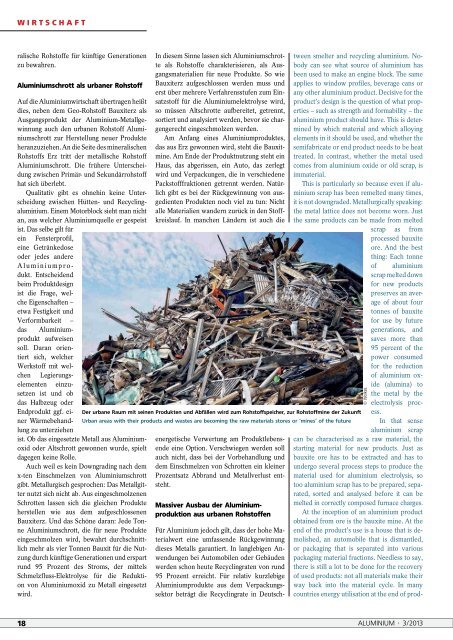special - Alu-web.de
special - Alu-web.de
special - Alu-web.de
You also want an ePaper? Increase the reach of your titles
YUMPU automatically turns print PDFs into web optimized ePapers that Google loves.
W IRTSCHAFT<br />
tween smelter and recycling aluminium. Nobody<br />
can see what source of aluminium has<br />
been used to make an engine block. The same<br />
applies to window profiles, beverage cans or<br />
any other aluminium product. Decisive for the<br />
product’s <strong>de</strong>sign is the question of what properties<br />
– such as strength and formability – the<br />
aluminium product should have. This is <strong>de</strong>termined<br />
by which material and which alloying<br />
elements in it should be used, and whether the<br />
semifabricate or end product needs to be heat<br />
treated. In contrast, whether the metal used<br />
comes from aluminium oxi<strong>de</strong> or old scrap, is<br />
immaterial.<br />
This is particularly so because even if aluminium<br />
scrap has been remelted many times,<br />
it is not downgra<strong>de</strong>d. Metallurgically speaking:<br />
the metal lattice does not become worn. Just<br />
the same products can be ma<strong>de</strong> from melted<br />
scrap as from<br />
processed bauxite<br />
ore. And the best<br />
thing: Each tonne<br />
of aluminium<br />
scrap melted down<br />
for new products<br />
preserves an average<br />
of about four<br />
tonnes of bauxite<br />
for use by future<br />
generations, and<br />
saves more than<br />
95 percent of the<br />
power consumed<br />
for the reduction<br />
of aluminium oxi<strong>de</strong><br />
(alumina) to<br />
the metal by the<br />
electrolysis process.<br />
In that sense<br />
aluminium scrap<br />
can be characterised as a raw material, the<br />
starting material for new products. Just as<br />
bauxite ore has to be extracted and has to<br />
un<strong>de</strong>rgo several process steps to produce the<br />
material used for aluminium electrolysis, so<br />
too aluminium scrap has to be prepared, separated,<br />
sorted and analysed before it can be<br />
melted in correctly composed furnace charges.<br />
At the inception of an aluminium product<br />
obtained from ore is the bauxite mine. At the<br />
end of the product’s use is a house that is <strong>de</strong>molished,<br />
an automobile that is dismantled,<br />
or packaging that is separated into various<br />
packaging material fractions. Needless to say,<br />
there is still a lot to be done for the recovery<br />
of used products: not all materials make their<br />
way back into the material cycle. In many<br />
countries energy utilisation at the end of prodralische<br />
Rohstoffe für künftige Generationen<br />
zu bewahren.<br />
<strong>Alu</strong>miniumschrott als urbaner Rohstoff<br />
Auf die <strong>Alu</strong>miniumwirtschaft übertragen heißt<br />
dies, neben <strong>de</strong>m Geo-Rohstoff Bauxiterz als<br />
Ausgangsprodukt <strong>de</strong>r <strong>Alu</strong>minium-Metallgewinnung<br />
auch <strong>de</strong>n urbanen Rohstoff <strong>Alu</strong>miniumschrott<br />
zur Herstellung neuer Produkte<br />
heranzuziehen. An die Seite <strong>de</strong>s mineralischen<br />
Rohstoffs Erz tritt <strong>de</strong>r metallische Rohstoff<br />
<strong>Alu</strong>miniumschrott. Die frühere Unterscheidung<br />
zwischen Primär- und Sekundärrohstoff<br />
hat sich überlebt.<br />
Qualitativ gibt es ohnehin keine Unterscheidung<br />
zwischen Hütten- und Recyclingaluminium.<br />
Einem Motorblock sieht man nicht<br />
an, aus welcher <strong>Alu</strong>miniumquelle er gespeist<br />
ist. Das selbe gilt für<br />
ein Fensterprofil,<br />
eine Getränkedose<br />
o<strong>de</strong>r je<strong>de</strong>s an<strong>de</strong>re<br />
<strong>Alu</strong>miniumprodukt.<br />
Entschei<strong>de</strong>nd<br />
beim Produkt<strong>de</strong>sign<br />
ist die Frage, welche<br />
Eigenschaften –<br />
etwa Festigkeit und<br />
Verformbarkeit –<br />
das <strong>Alu</strong>miniumprodukt<br />
aufweisen<br />
soll. Daran orientiert<br />
sich, welcher<br />
Werkstoff mit welchen<br />
Legierungselementen<br />
einzusetzen<br />
ist und ob<br />
das Halbzeug o<strong>de</strong>r<br />
Endprodukt ggf. einer<br />
Wärmebehandlung<br />
zu unterziehen<br />
ist. Ob das eingesetzte Metall aus <strong>Alu</strong>miniumoxid<br />
o<strong>de</strong>r Altschrott gewonnen wur<strong>de</strong>, spielt<br />
dagegen keine Rolle.<br />
Auch weil es kein Downgrading nach <strong>de</strong>m<br />
x-ten Einschmelzen von <strong>Alu</strong>miniumschrott<br />
gibt. Metallurgisch gesprochen: Das Metallgitter<br />
nutzt sich nicht ab. Aus eingeschmolzenen<br />
Schrotten lassen sich die gleichen Produkte<br />
herstellen wie aus <strong>de</strong>m aufgeschlossenen<br />
Bauxiterz. Und das Schöne daran: Je<strong>de</strong> Tonne<br />
<strong>Alu</strong>miniumschrott, die für neue Produkte<br />
eingeschmolzen wird, bewahrt durchschnittlich<br />
mehr als vier Tonnen Bauxit für die Nutzung<br />
durch künftige Generationen und erspart<br />
rund 95 Prozent <strong>de</strong>s Stroms, <strong>de</strong>r mittels<br />
Schmelzfluss-Elektrolyse für die Reduktion<br />
von <strong>Alu</strong>miniumoxid zu Metall eingesetzt<br />
wird.<br />
In diesem Sinne lassen sich <strong>Alu</strong>miniumschrotte<br />
als Rohstoffe charakterisieren, als Ausgangsmaterialien<br />
für neue Produkte. So wie<br />
Bauxiterz aufgeschlossen wer<strong>de</strong>n muss und<br />
erst über mehrere Verfahrensstufen zum Einsatzstoff<br />
für die <strong>Alu</strong>miniumelektrolyse wird,<br />
so müssen Altschrotte aufbereitet, getrennt,<br />
sortiert und analysiert wer<strong>de</strong>n, bevor sie chargengerecht<br />
eingeschmolzen wer<strong>de</strong>n.<br />
Am Anfang eines <strong>Alu</strong>miniumproduktes,<br />
das aus Erz gewonnen wird, steht die Bauxitmine.<br />
Am En<strong>de</strong> <strong>de</strong>r Produktnutzung steht ein<br />
Haus, das abgerissen, ein Auto, das zerlegt<br />
wird und Verpackungen, die in verschie<strong>de</strong>ne<br />
Packstofffraktionen getrennt wer<strong>de</strong>n. Natürlich<br />
gibt es bei <strong>de</strong>r Rückgewinnung von ausgedienten<br />
Produkten noch viel zu tun: Nicht<br />
alle Materialien wan<strong>de</strong>rn zurück in <strong>de</strong>n Stoffkreislauf.<br />
In manchen Län<strong>de</strong>rn ist auch die<br />
energetische Verwertung am Produktlebensen<strong>de</strong><br />
eine Option. Verschwiegen wer<strong>de</strong>n soll<br />
auch nicht, dass bei <strong>de</strong>r Vorbehandlung und<br />
<strong>de</strong>m Einschmelzen von Schrotten ein kleiner<br />
Prozentsatz Abbrand und Metallverlust entsteht.<br />
Massiver Ausbau <strong>de</strong>r <strong>Alu</strong>miniumproduktion<br />
aus urbanen Rohstoffen<br />
Für <strong>Alu</strong>minium jedoch gilt, dass <strong>de</strong>r hohe Materialwert<br />
eine umfassen<strong>de</strong> Rückgewinnung<br />
dieses Metalls garantiert. In langlebigen Anwendungen<br />
bei Automobilen o<strong>de</strong>r Gebäu<strong>de</strong>n<br />
wer<strong>de</strong>n schon heute Recyclingraten von rund<br />
95 Prozent erreicht. Für relativ kurzlebige<br />
<strong>Alu</strong>miniumprodukte aus <strong>de</strong>m Verpackungssektor<br />
beträgt die Recyclingrate in Deutsch-<br />
Der urbane Raum mit seinen Produkten und Abfällen wird zum Rohstoffspeicher, zur Rohstoffmine <strong>de</strong>r Zukunft<br />
Urban areas with their products and wastes are becoming the raw materials stores or ‘mines’ of the future<br />
© Wolkes<br />
18 ALUMINIUM · 3/2013
















